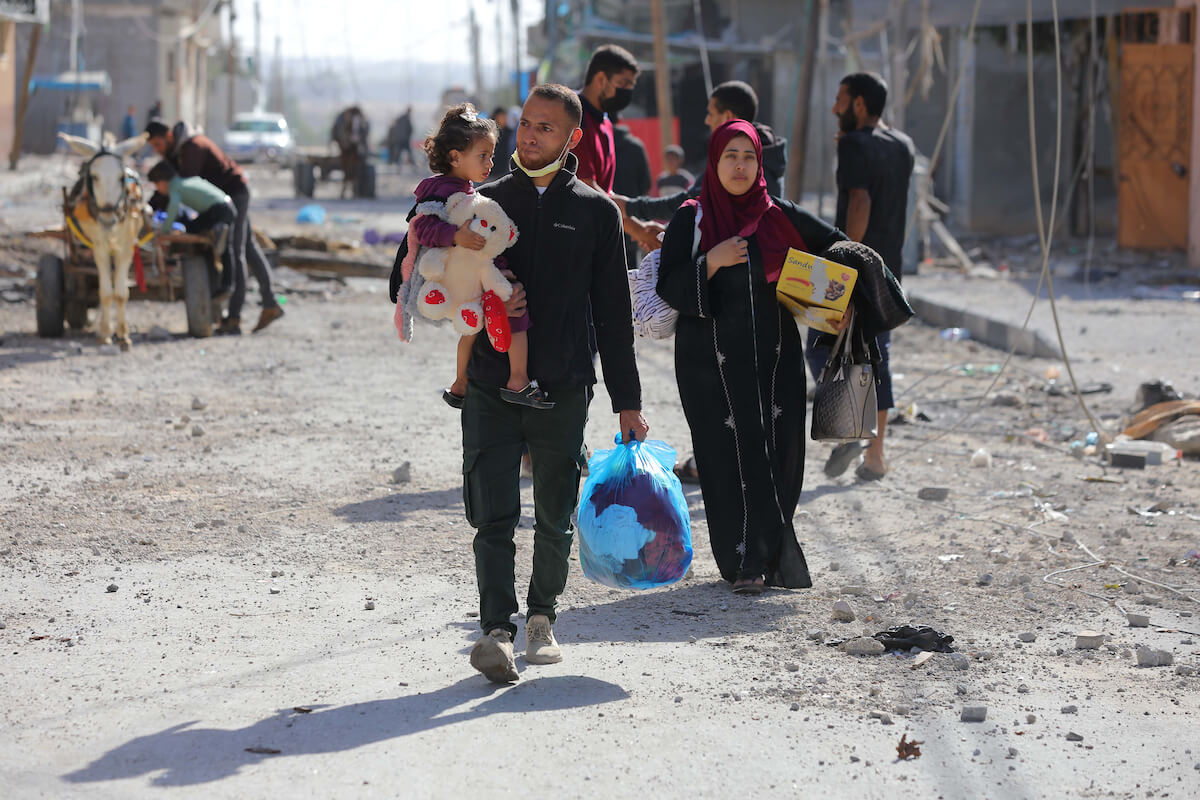The streets were suddenly flooded. People could now inspect the destroyed buildings in Khan Younis, in Nuseirat, in Deir al-Balah, and other cities in the south, able to venture farther away from their shelters to bring supplies for their families. Above all, they could now check in on the members of their family who were still alive, with whom contact had been severed throughout the war.
They are now able to seek each other out, to cry together over what they have lost and what they may yet lose.
The “temporary ceasefire,” if that is what they are calling it, doesn’t mean an end to the war. It simply means we are afforded more time to weep and to grieve.
Even though the fighting immediately preceding the truce was some of the fiercest since the start of the war, people were holding out hope that it would end in a ceasefire that would allow them safe passage back north to their homes in Gaza City and north of the Gaza Valley.
Yesterday in the early morning, Israeli warplanes dropped several leaflets for the people that remained in northern Gaza, warning them not to move outdoors. The Israeli army also called random cell phone numbers of registered Gaza City residents, warning them not to return north of the Gaza Valley. Both the leaflets and the phone calls sent the same message: the war is not over, and returning to your home is returning to your death.
But the families that have been torn apart by the genocide and spent over a month displaced are desperate for any word of the fate of their loved ones who remained. Many also desire to return to where their homes once stood, perhaps to salvage what they can from the rubble, including supplies, important belongings, and official documents.
Ahmad Lafi, 34, from the Sheikh Radwan neighborhood, fled south to Khan Younis along with his wife and two children at the start of the war, leaving behind his mother and father, his two sisters, and his two brothers. He told Mondoweiss that he lost contact with them two weeks ago, and has no idea if they are alive. Neither the Red Cross nor any other organization has been able to assist him in his attempt to find word of their whereabouts.
Yesterday, he tried to go to Gaza City with droves of other refugees seeking to do the same thing. When they reached the checkpoint on Salah al-Din Street, and before getting within 100 meters of the Israeli armored vehicles, soldiers began firing tank-mounted machine guns in the crowd’s direction.
Immediately, dozens of people fell to the ground, gravely wounded, and a few others were killed by the machinegun fire, Ahmad told Mondoweiss. They turned and ran in the other direction after that.
Later in the day, the Gaza government authorities announced the death of two martyrs from the incident, and reported over 15 people injured with live ammunition to the legs and chest.
The terms of the ceasefire allowed for the passage of people who remained in the north to the south, but the same does not apply to those wishing to go in the other direction. Analysts are saying that the lack of such a stipulation in the ceasefire’s terms means that the new military occupation of northern Gaza has been solidified.
Shaher Abu Shirbi, 42, is a father of six children and a refugee staying at an UNRWA school in Khan Younis. He had hoped that the truce would give him the chance to return to Beit Hanoun in the north.
“Even if it’s dangerous, I want to check on my house. Even if it’s demolished, I want to take one last look at it,” Shaher told Mondoweiss.
Shaher says that in the rush to flee the bombardment, he and his wife had not been able to pack that many belongings and had left behind important items such as their IDs and their children’s birth certificates. They also didn’t bring enough clothes with them and are struggling to find warmer clothes to wear as winter approaches.
Maybe these priorities don’t seem so essential to some amid all the death and destruction. But once the ceasefire took effect, regardless of what people thought of it, it had the effect of giving some people a sliver of hope. Some families that stayed in the north throughout the fighting have also chosen to remain there, even after the ceasefire is over. But those families have received little reprieve from the truce because it only afforded them the chance to fully comprehend the extent of what they lost.
Shahd Matar, who lost two of her brothers during an airstrike in the Jabaliya refugee camp, where she and her family still live, wrote on Facebook during the ceasefire:
“The truce, for us, turned our house into a funeral home, as people started to go to each others’ homes to express their condolences. For the first time during the war, and since the death of my two brothers, our neighbors and friends streamed in to express their condolences to me and my mother,” she said.
“But my mother has taken to sitting in one corner of the house, and she can’t stop crying,” Shahd continued. “Only today have we realized that they’re gone. Only today do we feel death’s presence here.”
At Mondoweiss, we understand the power of telling Palestinian stories. For 17 years, we have pushed back when the mainstream media published lies or echoed politicians’ hateful rhetoric. Now, Palestinian voices are more important than ever.
Our traffic has increased ten times since October 7, and we need your help to cover our increased expenses.
Related posts:
Views: 0
 RSS Feed
RSS Feed

















 November 25th, 2023
November 25th, 2023  Awake Goy
Awake Goy 
 Posted in
Posted in  Tags:
Tags: 
















